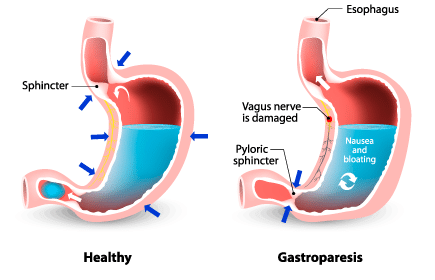Click here to download a PDF of this information.
Gastroparesis
 The term ‘gastro’ refers to the stomach, and ‘paresis’ means partial paralysis; therefore, gastroparesis means partial paralysis of the stomach. To understand what goes wrong in gastroparesis, it is important to know how a healthy digestive tract functions. When we eat, we start by chewing and swallowing, which requires conscious effort. Once the food reaches the esophagus, an automatic, rhythmic motion (peristalsis) takes over, propelling the contents all the way through the digestive tract. Typically, the passage of food from one area of the digestive tract to the next is precisely coordinated, so that food stays in each area for just the right amount of time. For the stomach, this is approximately two hours.
The term ‘gastro’ refers to the stomach, and ‘paresis’ means partial paralysis; therefore, gastroparesis means partial paralysis of the stomach. To understand what goes wrong in gastroparesis, it is important to know how a healthy digestive tract functions. When we eat, we start by chewing and swallowing, which requires conscious effort. Once the food reaches the esophagus, an automatic, rhythmic motion (peristalsis) takes over, propelling the contents all the way through the digestive tract. Typically, the passage of food from one area of the digestive tract to the next is precisely coordinated, so that food stays in each area for just the right amount of time. For the stomach, this is approximately two hours.
However, in those with gastroparesis, the food does not move from the stomach into the intestine as quickly as it should (delayed gastric emptying). Gastroparesis is a motility disorder, which means there is no physical obstruction preventing timely digestion, but rather a problem with muscular activity regulation. It occurs when the pair of nerves that connects the brainstem to the gastrointestinal tract (vagus nerve) is damaged or not functioning properly. Since the vagus nerve is unable to send the necessary messages to ensure that the muscles in the stomach continue to work normally, food remains in the stomach for too long.

Causes of Gastroparesis
The most common cause of gastroparesis is diabetes mellitus type 1 or type 2. High levels of glucose in the blood can cause chemical changes to the vagus nerve. This type of gastroparesis can be especially dangerous, because the delayed gastric emptying leads to more intense blood sugar spikes in those with diabetes, causing a cycle of blood sugar highs and lows that continues to affect the vagus nerve.
Gastroparesis is typically associated with some form of damage to the vagus nerve, which can occur in a range of situations, including from various mineral deficiencies, eating disorders, medications that affect gastric emptying (e.g., opioid medications, certain antidepressants, glucagon-like peptide-1 (GLP-1) receptor agonists (e.g., semaglutide)) and surgeries in the upper gastrointestinal tract, such as gastrectomy, bariatric surgery, or anti-reflux surgery. Other causes of gastroparesis, although rare, include connective tissue diseases such as scleroderma and Ehlers-Danlos syndrome, and neurological conditions such as Parkinson’s disease. In about a third of cases, the cause of gastroparesis is unknown (idiopathic). In some cases, such as those caused by certain medications or eating disorders, the gastroparesis can be temporary, with normal digestive function returning upon medication adjustment or adapting to healthy eating habits.
Prevalence of Gastroparesis
Gastroparesis affects approximately 4% of the population and is more common in women. Many people with gastroparesis also have diabetes, and 50% of those affected had diabetes before the onset of their gastroparesis.
Gastroparesis Symptoms & Complications
The most common symptoms of gastroparesis include feeling full from even small amounts of food, nausea, vomiting, reduced appetite, abdominal pain, heartburn or gastroesophageal reflux disease (GERD), and regurgitation. These symptoms can lead to weight loss and nutrient deficiencies. Other symptoms include bloating, muscle weakness, and night sweats. Since the digestive system doesn’t work smoothly, those with the condition also experience periods of low blood sugar while the food remains in the stomach, and high blood sugar when it eventually reaches the intestines.
Sometimes, more severe complications can occur due to delayed gastric emptying. Individuals can experience obstructions caused by masses of solid hardened food (bezoars). Often, bezoars will pass on their own, but other times they require treatment in the form of oral solutions to help dissolve them or, in severe cases, surgery.
If excessive vomiting is a symptom, it can cause its own set of complications, including dehydration and malnutrition. In those who have diabetes and gastroparesis, controlling blood sugar can become very difficult due to the irregular release of food into the small intestine.
Diagnosing Gastroparesis
Your physician will review your symptoms and medical history and complete a physical examination, including blood tests. If your doctor thinks you might have gastroparesis or is unsure and wants to rule out other diseases and disorders, there are a few tests available. This is especially important with gastroparesis, because many of the symptoms are similar to other conditions, such as functional dyspepsia.
Gastric emptying scans allow your healthcare team to measure the speed at which you digest food. For this test, you consume a tiny amount of radioactive material with a small meal, which allows technicians to monitor the rate at which it passes through your digestive system by periodically using a camera to check where the radioactive meal is. If it stays in the stomach for too long, then it can indicate gastroparesis.
An upper gastrointestinal series involves consuming a barium drink in front of an x-ray machine after fasting. The barium is a chalky liquid that shows up on x-rays, allowing the technicians to see details in the gastrointestinal tract. This can help them find any anomalies in stomach function.
Gastroscopy involves a physician using a small, flexible tube with a camera and a light (endoscope) to look at the upper parts of the digestive system, including the esophagus, stomach, and duodenum. This test is helpful to detect bezoars or any other abnormalities in the stomach.
Abdominal ultrasound is useful for identifying if there are any physical abnormalities that might be causing symptoms.
Gastric or duodenal manometry involves using a long thin tube that measures muscle strength and patterns within the esophagus and through the lower esophageal sphincter into the stomach.
Management of Gastroparesis
The management of gastroparesis can include dietary changes, medications, and even surgery depending on the disease severity.
Lifestyle and Dietary Changes
In individuals with mild gastroparesis, a few changes to dietary habits can largely reduce symptoms. Most of these changes focus on reducing the amount of food you eat at once, because overeating makes it even more difficult for your stomach to empty. Consuming smaller meals more frequently, rather than two or three large meals, can help. You may also find relief by eating mostly soft or liquid foods, such as soups and smoothies. Chewing each bite very well and consuming non-fizzy liquids with meals can also make digestion easier. Avoiding or limiting high fibre and high fat foods can reduce discomfort, since these foods typically take longer to digest. For some individuals, supplemental nutrition beverages can help ensure adequate nutrient intake.
If you have diabetes, make sure to keep glucose tablets or hard candies on hand. Since they are easily and quickly absorbed, you can use them to raise your blood sugar if gastroparesis is causing low blood sugar. A registered dietitian can offer advice if you are unsure what to eat to meet your nutrition requirements when you have gastroparesis.
Medications
The medications available for gastroparesis don’t treat the underlying disease, but they help to alleviate symptoms. There are two primary medication types available:
Motility agents increase the speed of peristalsis, causing the stomach to empty more quickly, and include domperidone and metoclopramide. NOTE: Health Canada pulled a gastroprokinetic agent, cisapride, from the market at the turn of the century due to serious health concerns and deaths. However, some physicians still cautiously prescribe cisapride, which increases motility in the upper gastrointestinal tract, for severe cases of gastroparesis. Compounding pharmacies can acquire the drug under special circumstance.
Antiemetics reduce nausea and vomiting and include medicines such as prochlorperazine and promethazine.
Research is ongoing to develop new medications for gastroparesis. Clinical trials are also investigating the efficacy of existing drug therapies, such as prucalopride (Resotran®).
Surgery
For those who are unable to get symptoms under control through dietary changes and medications, there are a few surgical options that may offer relief.
A gastric electric stimulator is an implanted device that uses mild, controlled electrical pulses to stimulate the smooth muscles in the digestive tract and speed up gastric emptying. However, this treatment does not work for everyone, and is not available in all areas.
Botox (botulism toxin) injected in the sphincter that connects the stomach to the small intestine (pylorus) can help relax the sphincter so that it more easily allows food passage into the small intestine. Botox injections don’t work for everyone, they are only a temporary solution, and can become less effective in subsequent injections.
A feeding tube surgically attached at the entry to the small intestine can offer a last resort for those who are completely unable to take nutrients into the stomach in either solid or liquid form.
Gastroparesis Outlook
Gastroparesis is typically a chronic condition with potentially dangerous symptoms and complications. For some individuals, being more careful about the frequency and types of foods they consume is enough to live a relatively normal life, but for others, ongoing medications and even surgery might be necessary. Those who have both diabetes and gastroparesis need to be especially diligent in managing both conditions. Quality of life is often diminished with gastroparesis, as the symptoms can be severe, painful, and distressing, and can interfere with work, school, and social life. However, there are many treatments that offer hope, and new research regularly being conducted to improve life for those living with gastroparesis.
Want to Learn More?
- Gastroparesis Story
- Gastroparesis Patients Willing to Take Massive Risks for Cure
- Diabetes and the Gut

